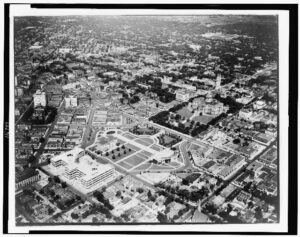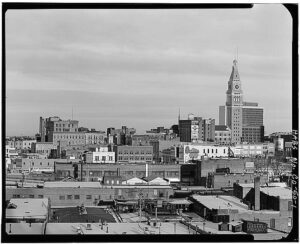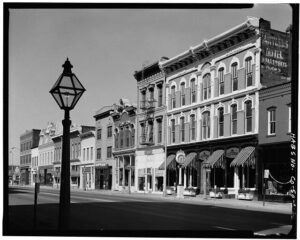Dating way back into the mid and late 1800’s starting with the insurgence of the first stone quarry workers and civil war recovering women and men from the East and South, or coming from the dried-up mines of the California 49ers gold rush, Denver has gone thru several stages and phases of redevelopment.
The First Construction in Denver




From the first tents and shack’s along Cherry Creek to Horace Tabors Grand Opera House on 16th & Curtis Street, Denver, a relatively young city, has always been driven by opportunists and business entrepreneurs. Denver’s population in 1870 was around 4,800. After the Railroads made its way west, Denver’s population grew to over 100,000 in 1890. Much of the city layout as we know it today is due to the efforts of Mayor Robert Speer who is created with initiating the City Beautiful Movement that included the building of Civic Center Park, Denver Zoo and the Denver Museum of Nature and Science.
Moving forward to post-depression and WWII, Denver changed again. With large scale housing shortages and the passing of the New Deal in conjunction with the passing of the National Housing Act in 1934, mortgages became more widely available which started the establishment of a larger middle-class moving into the suburbs.
Consequently, the creation of the Federal Housing Authority (FHA) act allowed developments to be subsidized and suburbs to expand even further away from downtown. It is estimated that between 1940 and 1949 Denver and its urban areas grew by 16,000 new homes and the city’s population increased by about 90,000 people. Overall population increased overall from around 400,000 in 1940 to just about 1.0 Million around 1965.
Modernizing Denver
In 1967 Denverites approved the Urban Skyline Renewal Project. As part of these large-scale developments, the city lost a large amount of previously protected, historic buildings and sites to the high-rise office and residential buildings we still enjoy today.
Furthermore, by the late 1970s and early 1980s, Denver had established itself as a mainstay in the oil and gas industry. Occupying The majority of the office spaces in Denver were these companies and Denver’s economy was highly fossil fuel-driven. By 1986 oil prices had dropped to nearly $9 per barrel and Denver has hit with a devastating recession that crippled the real estate and job markets. As a result of declining land prices of as much as 80%, development halted for years as the economy recovered. By the 1990s the tech industry had appeared in Denver and created a corporate influx that’s lasted decades. Due to the relatively constant population growth since then has brought development to Denver Metro that’s continually changing Denver’s landscape.
The Next Phase of Denver
Today, as evident by the many cranes marking our skyline, Denver is going through its next phase of redevelopment. Long gone are the days of Horace (“Haw”) Tabor and the likes of Governor John Evans who was one of the founders of the University of Colorado. New local, national and international conglomerates are calling Denver and its suburbs home and are providing a large number of jobs and hence a driving economy surrounding them.
With the pro-business political environment and the desirability of Colorado, we’re seeing a huge population increase in the Denver Metro and other Colorado urban centers. Due to that, new areas of Denver are seeing a revitalization. This includes the Lower Highlands (LoHi), River North (RiNo), Five Points, City Park, Washington Park and numerous other areas that have previously been stagnant for decades.
Adapting to Denver’s Citizens
The citizens of Denver have also become more sensitive to the town’s history and heritage and sizable efforts are being made to protect any leftover historic buildings and sites. These rules, although not viewed as development opposed, aim to preserve the important history of this buzzing town. Designers, Developers, and Contractors have and need to, adapt to this new environment. In an economy where the bottom line has a much higher priority, these rules will require a much higher level of contractor input into the redevelopment of these sites.
In addition to the recognition of historic sites, we are also navigating evolving environment requirements aimed to enhance building energy efficiencies. Development teams are tasked to build higher energy efficiency building envelopes, MEP systems and other building components aimed at reducing the overall building carbon footprint. We are even seeing self-sustaining buildings (aka “net zero”) where the energy required is produced via a sustainable source. These requirements have all impacted the way designers, developers and contractors relate to one another.
Critical Roles of the Construction Process
As it is, these buildings and complexes are built with the involvement of General and Sub-Contractors. All the incredible designs and visions we see today had to be put into reality via Contractors (i.e. construction teams). Architects, Designers, and Planners deserve a lot of credit, but equal credit should be given to the people on the ground from mixing brick mortar to installing solar panels – the Contractors.
In our current desire to find more efficient ways to design, construct and operate these buildings, the traditional ways of our industry have undergone a substantial renewal as well. Contractors are not merely a commodity to execute a completed design. Contractors are tasked with a multitude of services long before putting the first shovel into the ground. It is very common these days that contractors are either hired at the same time the design teams are or even tasked solely with the design and construction (i.e. Design-Build).
PRESERVING DENVER’S HISTORY IN CONSTRUCTION
As Denver’s landscape changes there are historic areas of Denver transforming into centers of commerce, housing, and entertainment. Subsequently, buildings within these areas are often deemed ‘historic’ by various entities and must be treated differently than traditional renovation and adaptive reuse projects. To comply with these historic standards, extensive attention to detail must happen during pre-construction/design as well as during construction efforts. This can include procurement of industry-leading subcontractors to perform meticulous work to maintain a building’s historic components.
The last necessity, and often the most delicate component of construction, is cost control. The all-too-common stereotype of general contractors being opportunistic with cost changes related to scope changes is unfortunate. Most importantly, it’s critical that your general construction partner is ethical and trustworthy since these projects are full of on-the-fly changes in scope. There are contractual measures to help mitigate this risk but the fundamentals of the general contractor should be felt and realized throughout the project.
A contractor’s intimate knowledge of costs and critical construction details leads to a much more cohesive relationship and a more desirable result.